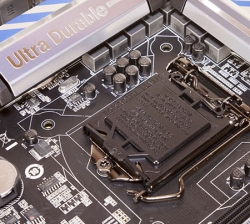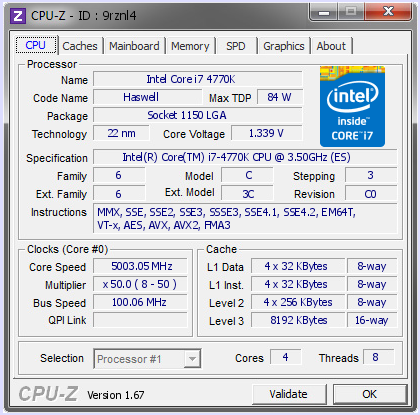BIOS -
BIOS is an acronym that stands for Basic Input/Output System. It is meant to control your product at a very low level. As of right now there are three regularly used BIOS formats (there are actually more than that but there are three common ones). These are the AMI (American Megatrends Incorporated), Award, and Phoenix. Of course with the introduction of the UEFI (Unified Extensible Firmware Interface) we now have a solid basis for the “BIOS” on new motherboards. This actually gets away from the term BIOS (Basic Input/Output System) and becomes more of a software interface. Each manufacturer will have their own take on how to implement this; some good, some not so good.
Gigabyte has moved away from the “3D” Bios layout that they were employing when the UEFI standard came out. This is a good thing as the older layout (and implementation) was sluggish and buggy. The new layout is much cleaner and offers improved performance and many options for customization. Check out our video below for more information.
Overclocking –
Overclocking is one of the fun parts of testing motherboards and CPUs (well really almost every component…). As Intel has developed their CPUs and Chipsets overclocking has become easier to accomplish for even a novice. CPUs and motherboards are designed with considerable headroom to allow for extra voltage and to handle the increase in speed. Gigabyte has been making some excellent progress in providing overclocking performance. They have worked hard to build their boards with the right components and trace layouts. This means that there is less potential for performance loss at high speeds due to signal issues. Using the Gigabyte Z87X-UD3H we were able to hit a high point for our 4770K. We did not need to use too much voltage to get there which is always a good thing. You can check out the CPUz validation below.
Of course overclocking is a picky subject. I can buy to identical CPUs from the store and they will not always perform the same way under stress. This is the same with motherboards, RAM and GPUs. So again it is important to keep in mind that our results represent a specific hardware configuration. Yours may be similar but will rarely be identical.
Overclocking Tools –
Gigabyte has made some changes to their overclocking tools and their application suite in general. They have moved away from the old UI and pushed into a much more modern and cleaner looking UI. The tools are a little updated as well. You can see the full suite in our video below.
The Test System and Comments -
Our test system is built on an open bench. This has two effects on testing. First it allows us to see everything and also to setup and disassemble the test rigs quickly. Second it means that we cannot gauge the potential air flow found in a normal case. The air is pretty stagnant; some may say this is a great neutral testing method and it can be. However, it does mean that the temperature reading taken off of the components are not accurate to what an average consumer would see. This means that your thermal performance will vary from what we see here. Over the last few months we have redesigned our lab to give us conditions closer to what an end user would have. We have ditched the completely open benches in favor of Cooler Master HAF X cases. These give us the ease of using a test bench but with the air flow of a real case. For cooling and power we also chose Cooler Master using their Eisberg 240 water cooling system and Silent Power Pro 1050 Watt PSUs. For drives and memory Kingston is our company of choice with us typically using their 16GB Hyper X 10th Anniversary kits (KHX24C11X3K4/16X) and Kingston SCK30/240G 240GB SSDs in both of our benches. We have also decided to stick with Windows 7 for now until we have completely validated Windows 8.1 with all of our tests. Currently there are still some benchmarks and real world applications that do not perform well on Windows 8.x systems. Once we can confirm these we will begin the move to using that OS as a testing platform.
Performance testing overview -
Our testing is a little different than most. We combine both synthetic and real-world applications to simulate the types of performance common to the individual products. For motherboards this means that we run roughly six synthetic tests and two real-world. We will be expanding the real-world testing in the near future. But there is more to performance than just the raw numbers. As there are multiple components and sub-components on a motherboard there each item can have a distinct impact on the way the product will perform once you get it in your system. It is important to note not only the actual results but what they mean to you as a potential consumer. We will try to give this information to you.
But we do not just cover the performance aspects that are measurable. We also talk about the components that might not have a direct benchmark. These are items like Audio Quality, ease of use and installation.
Section 1 Subsystems
Memory -
Memory performance is very important on a motherboard, especially when you have a CPU with multiple cores and threads. If you have slow memory your cores and threads can become starved for data to execute. To test memory performance we run both Sisoft’s SANDRA and AIDA64. These two combine to not only give us accurate numbers but to validate each other. For testing at stock speeds the memory is hard set to 16000MHz while overclocking testing is done at the highest stable speed for the voltage of 1.55v this is due to the different memory dividers for each CPU. As such, the memory speeds will vary greatly. This means that the overclocked numbers are a little misleading and while they can show a trend are really only included to show if a board has a problem with memory performance at high clockspeeds. We tried something a little different this time. Instead of using our normal 1600MHz, we went ahead and wanted to see what we would get from pushing to 2133MHz. This is the second XMP profile on the Kingston 10Th anniversary kit that we use. The results are interesting to say the least.
At stock speeds the 2133 move gives us a fairly significant improvement over 1660MHz (duh right?). What is interesting is that this is at the same command rate and latency used for 1600MHz (CL9 and 1T). This not bad considering the fact that we had to tinker quite a bit with older Z77 boards to see the same performance levels at the higher memory speeds. The Gigabyte Z87X-UD3H actually does a very good job in keeping data flowing.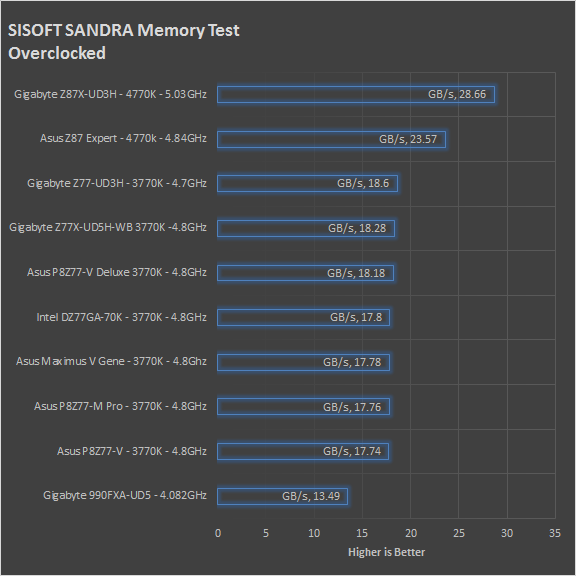 During our overclocked run we saw a very nice jump in memory performance (much more than we expected). Gigabyte really tightened the performance curve for both stock and overclocked performance, at least where memory is concerned. This boost in memory speed should give us good performance in rendering, multi-tasking, and even in gaming (level loads).
During our overclocked run we saw a very nice jump in memory performance (much more than we expected). Gigabyte really tightened the performance curve for both stock and overclocked performance, at least where memory is concerned. This boost in memory speed should give us good performance in rendering, multi-tasking, and even in gaming (level loads).
Drive performance -
Drive performance is also one of the major subsystems that goes to make up the performance of a motherboard. For our testing we use Sandra and AIDA64 again. We only test with single drives for each type of controller present on the motherboard (unless it is a professional product where we will use RIAD 5 and/or 10). We have also begun using a Thermaltake USB 3.0 dock with another Kingston SCK30/240G 240GB SSD and a Kingston HyperX USB 3.0 Flash drive for our USB 3.0 performance. As a side note, we include the overclocked numbers here to make sure (again) that you are not going to see a major drop in performance due to minor instabilities at high clock speeds. Here things get a little interesting. Although the Z87X-UD3H is using the same Intel SATA 3.0 controller as Asus’ Z87 Expert Gigabyte’s board pulls ahead nicely at both stock speeds and when we push the CPU. It is an added bonus that should yield results in many of our other tests.
Here things get a little interesting. Although the Z87X-UD3H is using the same Intel SATA 3.0 controller as Asus’ Z87 Expert Gigabyte’s board pulls ahead nicely at both stock speeds and when we push the CPU. It is an added bonus that should yield results in many of our other tests.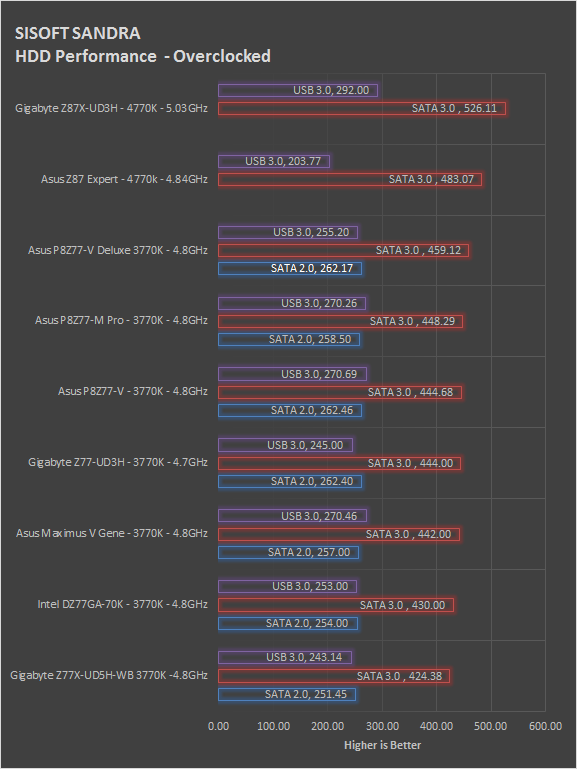
Power -
Power efficiency is another of those misnomers that we get caught up in. We hear about idle states and power gates. But what does that mean to you and I? On the surface having power management that reduces idle power sounds great and can be a benefit to someone that leaves their system on for long periods of time (and inactive) but how a system handles power under load and the delta between the two states is often more important than the idle power usage numbers. We use only P3 Kill A Watt instruments for measuring power.

Ok, now we had previously hoped that we would see a significant drop in load power usage when running a Haswell CPU, but sadly that has not really materialized. While the power draw under stock conditions is not much higher than Ivy Bridge, we are still seeing a little increase. The Gigabyte Z87X-UD3H continues this trend and even pushes it a little higher under full load.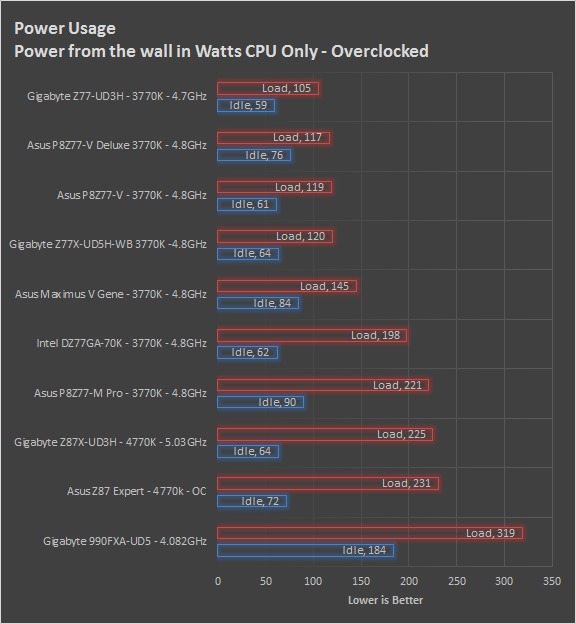 When overclocked the power draw is much higher (as you would expect).
When overclocked the power draw is much higher (as you would expect).
Cooling (Board Level) -
Board level cooling is an important factor in product performance and longevity. Components like the chipset, VRM modules and even capacitors need to be kept relatively cool to prevent failure. As these parts are made of silicon, they have a thermal breakdown threshold; or melting point. At that temperature the actual transistors built into chip will begin to deform and break down. Granted, the threshold is often very high, but you still need to make sure that components stay away from this level of heat for longer product life.

Gigabyte’s VRM cooling on the Z87X-UD3H does a very nice job at keeping your CPU power regulators cool. When it comes to the “chipset” it is not as efficient.
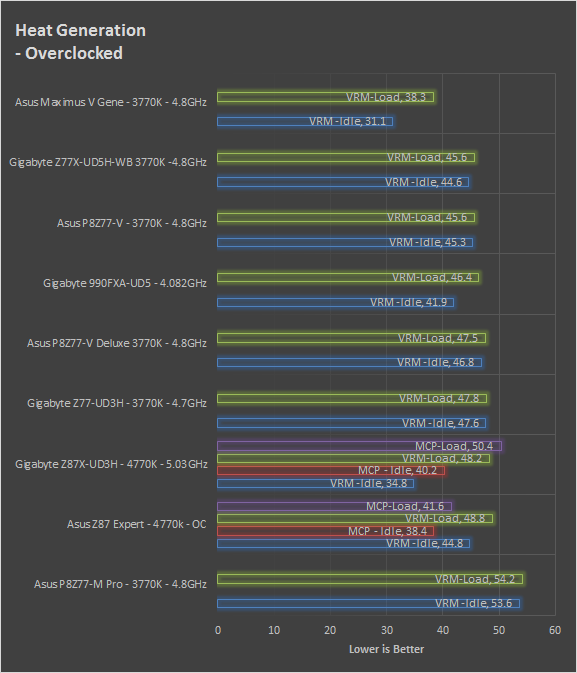
During overclocking the cooling still manages to keep things under control, but not as well as the cooling on some of the other Z77 boards.
Audio -
Audio is highly subjective. What we find pleasing may sound “off” to you. That is always going to the problem with testing audio; results will vary too widely depending on the tastes of the listener. However, there are ways of measuring the audio output with an objective ear. There is also the issue of audio causing performance issues in gaming and video playback. The reason this is a potential source of concern is that all onboard audio CODECs (Compression/Decompression) are CPU controlled. This means that while the audio chip controls the audio levels and effects of the audio the actual work is done on the CPU. Usually this will not be a problem with today’s powerful CPUs. Even the lower and consumer level products can handle high-end audio these days. But again there is the chance that a bad design or software will hinder your system and performance. On the other side the limits of board space, cost, etc will also prevent the level of audio quality you can get from an add-in board. We test all audio parts with three media types, Movie (DVD), MP3 Music, and Gaming. These are pushed to our Tec On model 55 Tube Amp to see if we can detect any signal issues in the reproduction.
We will simply say that the audio on the Z87X-UD3H falls into the good enough category. It will do what you need it to, but if you are looking for good audio you will want to look into other options.
Networking -
This one is something that is a requirement anymore. If you have a computer, the chances are good (like 99%) that you are also connected to high-speed internet. With this you need a good and solid LAN chip to make sure that your data flows properly out and back. Gigabyte made the move to Intel network controllers on their newer boards. This is a good move for them as Intel has one of the better performance profiles when it comes to networking. Intel also has a much wider compatibility range than many of the other options. We had zero performance issues with the Intel controller on the Z87X-UD3H.
Section II - Performance Tests, Synthetic
In this section of testing we cover the synthetics. These are tests that run a scripted sequence of internal APIs or that use another installed application to perform a series of scripted events. They are great in that they can provide reproducible results across various platforms. On the down side, synthetic tests can be fooled with driver tweaks and optimizations. In some cases it is necessary to rename the .exe file to something generic to discover if this is the case. In any event when this is needed (when a test shows a drastic difference in performance over the renamed exe) we will note this and show both results for comparison.
PCMark7 -
PCMark7 is the latest general performance test from FutureMark. As each generation of this benchmark has evolved and developed we have watched them add more and more realistic tests to this suite. With this generation we find more media tests, (audio and video transcoding) moving of large files, multiple web page rendering, and much more (the even added DX10 gaming). We use the Overall Performance and Common Usage suites in our testing.
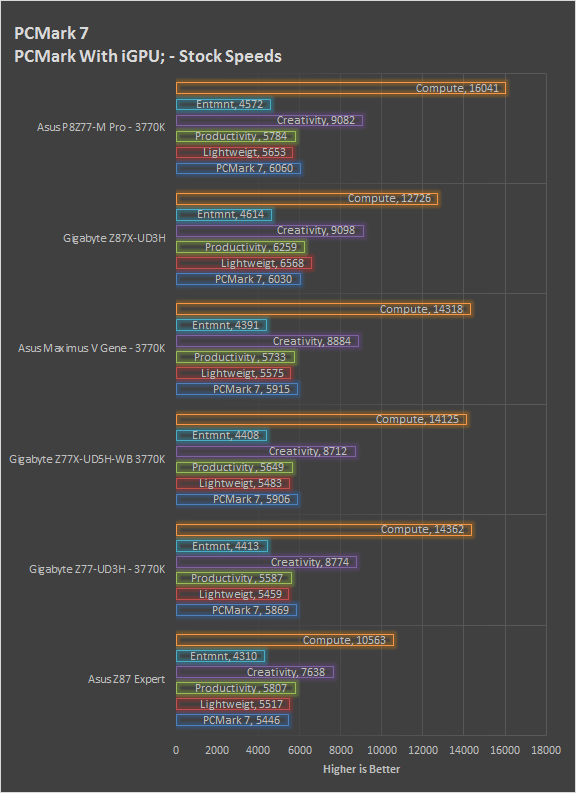
Our PCMark 7 results were interesting. On the Gigabyte Z87X-UD3H we saw a very similar performance hit as we did on the Asus Z87 Expert. This is despite faster memory and also a much more multi-media oriented CPU.
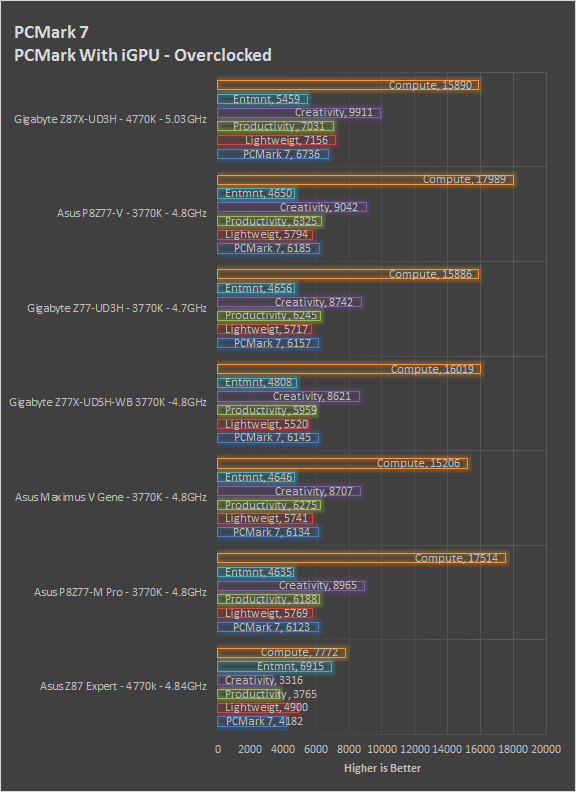
When we pushed the clock speed up to 5GHz things started running in the way we would expect with the Z87X-UD3H coming out on top.
PCMark 8-
PCMark 8 is a little bit of a departure from PCMark 7. Although the application is still intended for benchmarking and does that quite well the methods used to obtain the results are different. Futuremark has decided to break the tests into usage models instead of performance types. Here we see the tests aligned to the home, work, content creation (creative) and storage functions. We ran all of our tests at baseline (no OpenCL acceleration) to get the feel of the motherboard and its ability to run these tests.
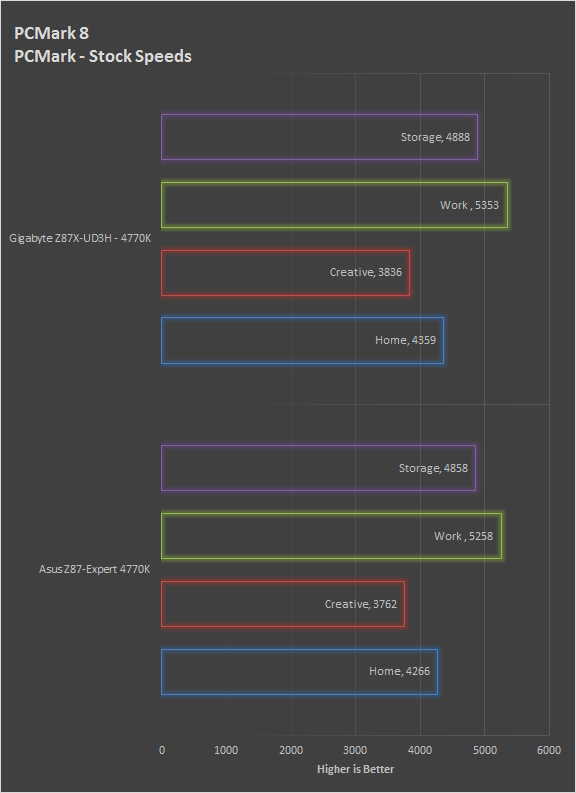
The Gigabyte Z87X-UD3H came out on top for all of the PCMark 8 tests. We see solid performance across the board at stock speeds and when overclocked.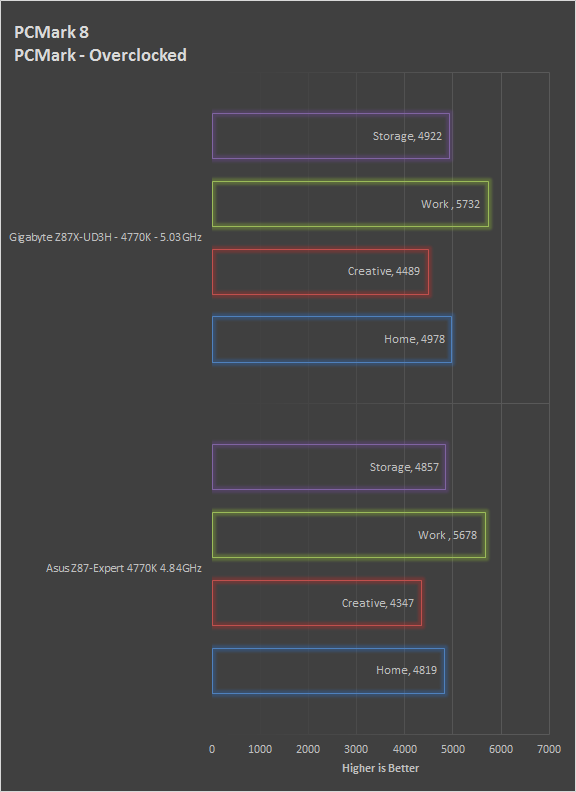
3DMark -
3DMark is the other Futuremark test that we run on our motherboards. This test simulates the typical tasks that a GPU (and system) would have to perform to provide you with a good gaming experience. It is based on the DX9, DX10 and DX11 engines but can only be installed on Windows Vista or later. The suite of tests covers DX9, DX10, and of course DX11 rendering; it also covers AI computations and physics. That’s right I said Physics the latest version of 3DMark uses a Havok physics engine. This removes the advantage that nVidia had with 3DMark Vantage.
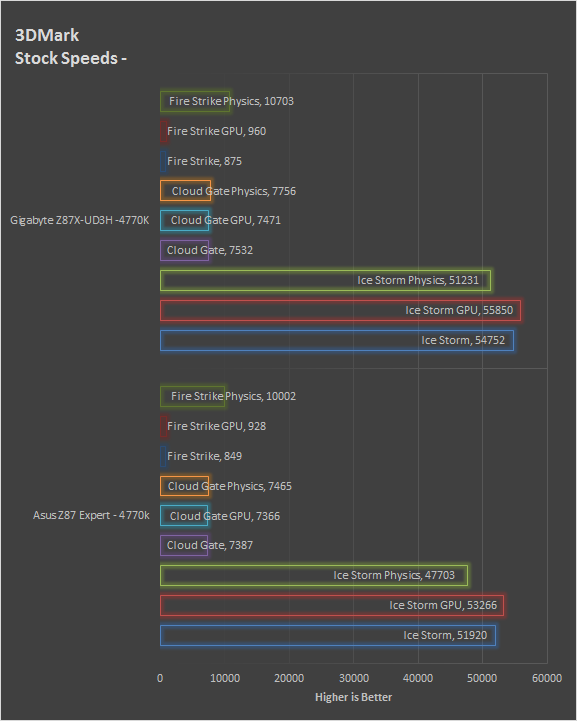
Gigabyte’s Z87X-UD3H also does quite well with 3DMark. We see it squeeze past Asus’ Z87 Expert to come out on top. This should be good news for our gaming test although we really cannot properly gauge performance by a synthetic test.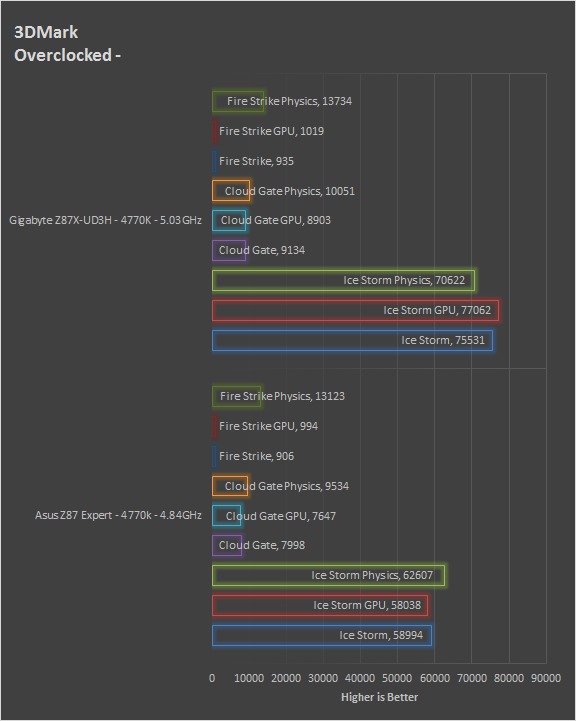
HyperPi 0.99b -
HyperPi is a front end application that allows you to easily run multiple instances of the SuperPi application. SuperPi, for those that are not familiar with it, is an application that measures the time it takes to calculate the number Pi out to as many as 32 million places. This calculation is then checked and run multiple times (up to 24 for a 32M run). This test stresses the CPU, Memory and HDD as data is handed off between the three. If there is a weak link, HyperPi will show it. For our testing we run the 32M test on as many cores (and threads) as the CPU has available. The slowest CPU time is then recorded. The blue bars indicate the slowest time while the red indicate the fastest.
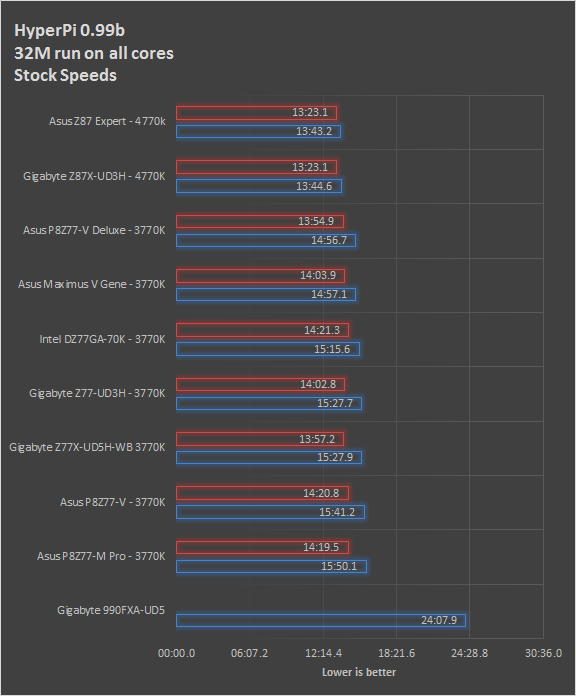
Under HyperPi the Gigabyte Z87X-UD3H does well, but at stock speeds it does not come out on the top of the heap. We see if fall into second place by a little more than a second at its slowest run (it tied for first under its fastest run). When we kicked the CPU up to 5GHz we see it pull out in front by over 2.5 minutes.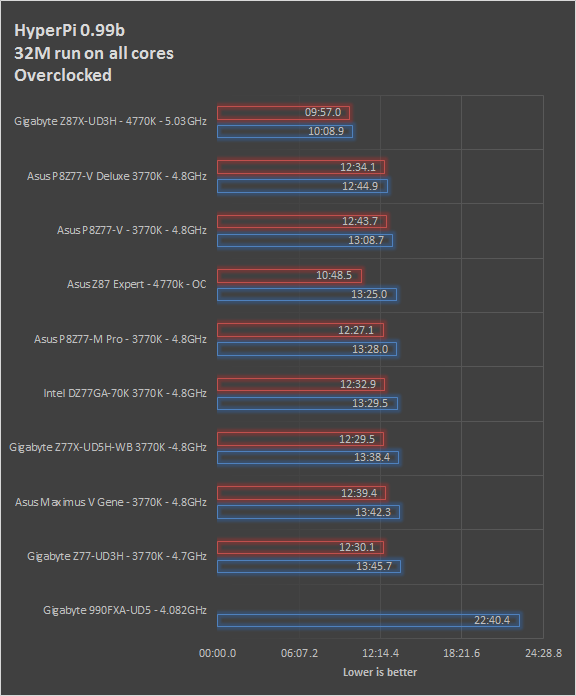
Cinebench R11.5 -
Cinebench R11.5 is the 11th release of Maxon’s rendering test. This test is based off of the Cinema 4D engine, which is one of the industry standard tools for digital animation. It is a powerful product with many different modules that can be “plugged” into it to increase its effectiveness. With Cinebench you get to see how your computer would do using this application. There are two tests; one tests the CPU’s ability to render an image across multiple cores or threads. The other tests your systems ability to handle OpenGL based rendering.
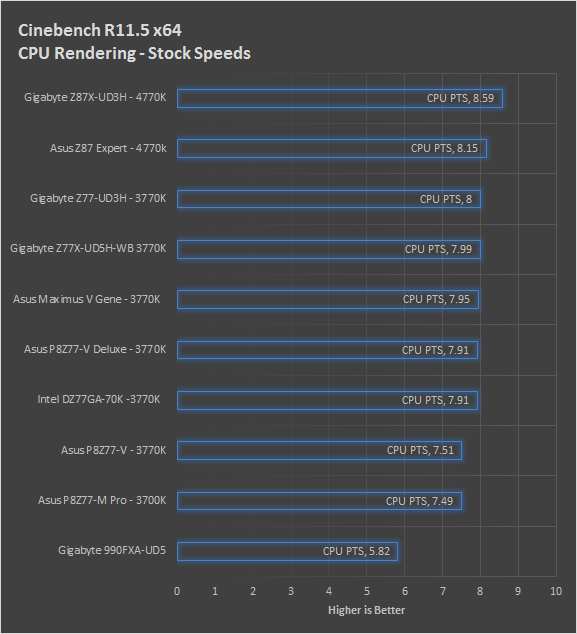
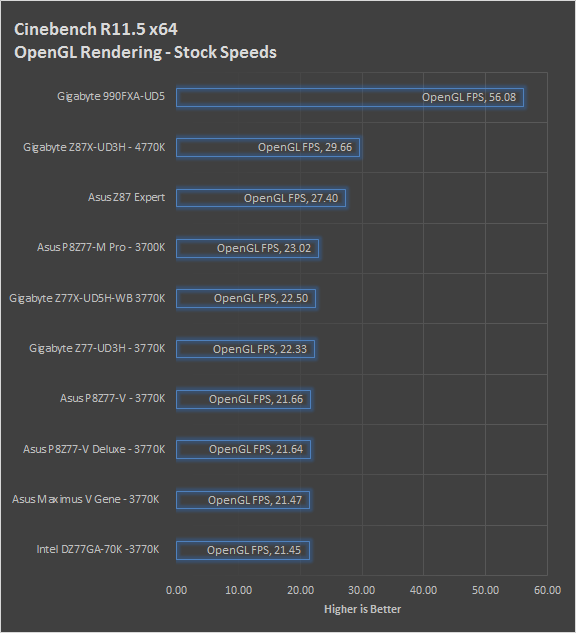
The Z87X-UD3H pulls out in front for the synthetic Cinebench R11.5 testing. We see solid performance at both stock and overclocked speeds. This typically indicates that we will see good performance in our real-world Lightwave test.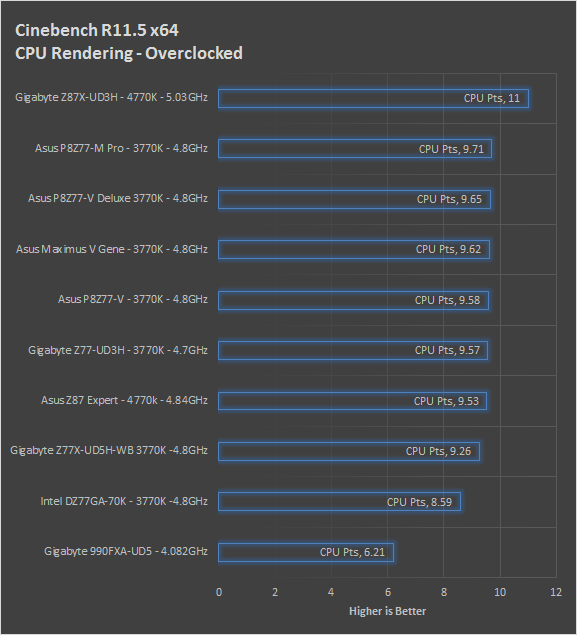
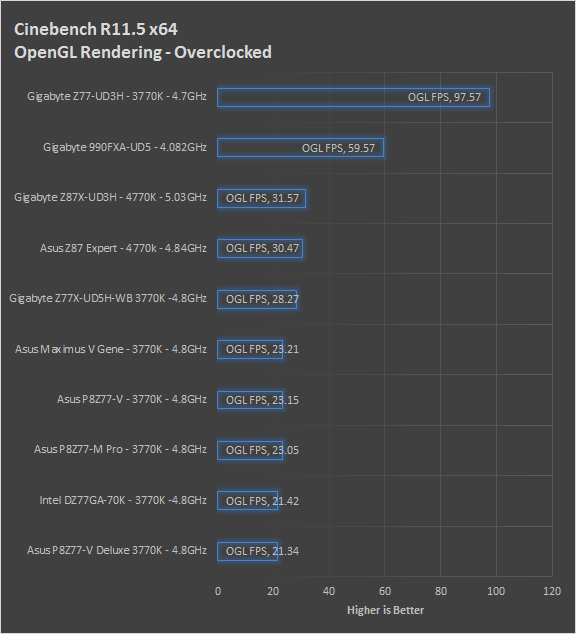
Cinebench R15 -
Cinebench R15 is the 15th release of Maxon’s rendering test. This test is based off of the Cinema 4D engine, which is one of the industry standard tools for digital animation. It is a powerful product with many different modules that can be “plugged” into it to increase its effectiveness. With Cinebench you get to see how your computer would do using this application. There are two tests; one tests the CPU’s ability to render an image across multiple cores or threads. The other tests your systems ability to handle OpenGL based rendering. We are moving to Cinebench R15 for all future reviews.
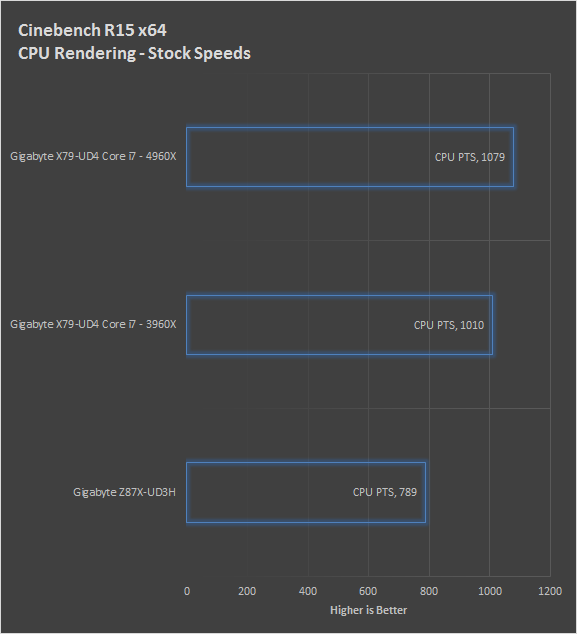
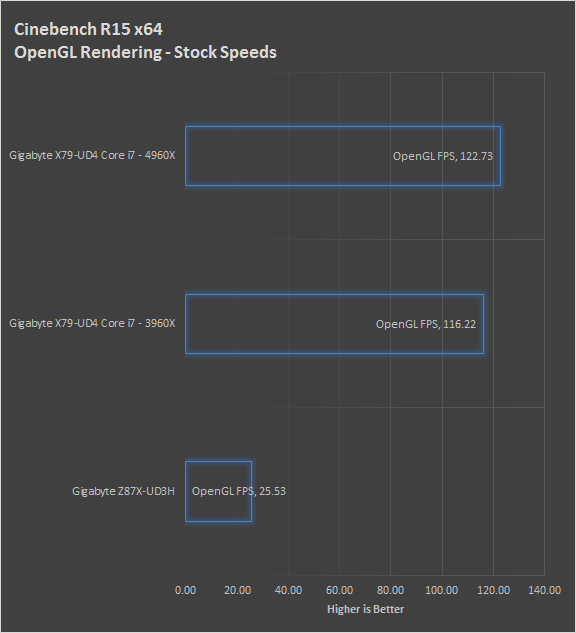
The Z87X-UD3H also is out in front for our Cinebench R15 testing. We see solid performance at both stock and overclocked speeds. Unless we run into another issue we expect very good rendering performance in our real-world testing.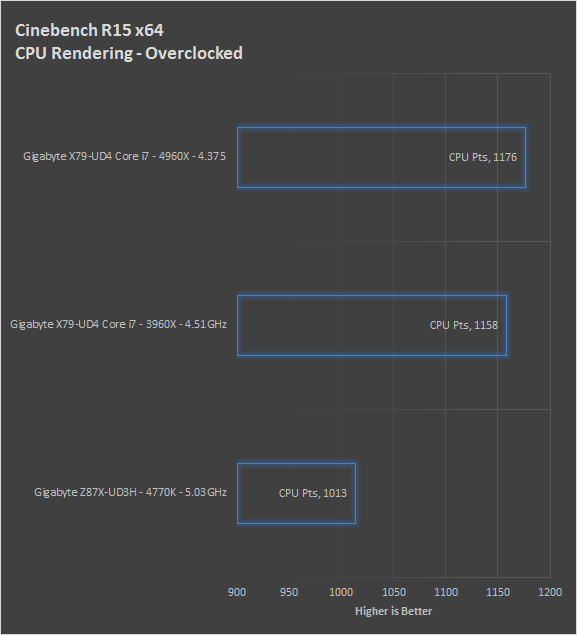
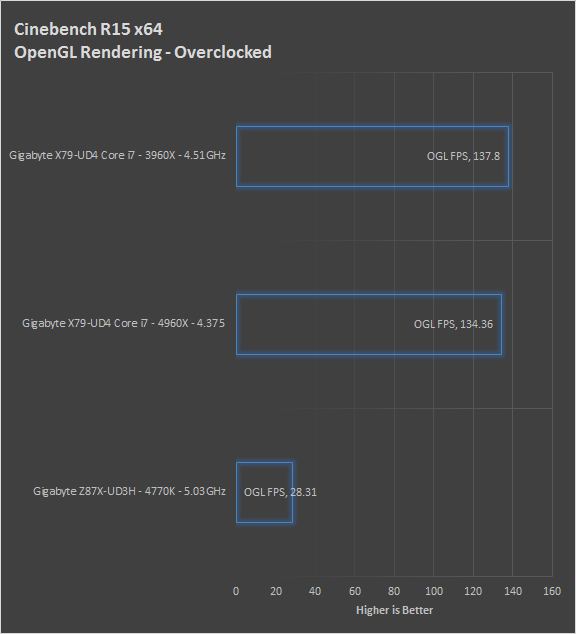
Section III - Performance Tests, Real-World
Here we have two tests that are designed to put the performance of the motherboard and its subsystems to the test. Both require good CPU, Memory, HDD and even to a lesser extent audio and network performance. The two tests we chose were Lightwave 3D 9.6 and CyberLink’s Media Espresso. We will be adding at least one more real-world test to this battery in the near future, but for now these two cover quite a bit.
Lightwave 3D 9.6 x64 -
Lightwave is another industry standard application for 3D animation and rendering. It has a large tool base and the rendering engine is highly threaded (when using the right render model). This application is also capable of expanding to 4k resolutions as well as ray tracing for rending the light sources. For our testing we use frame 470 of the Pinball scene found in the LW 9 Content folder. This uses the newer perspective camera that is better suited to a multi-CPU/Core environment. This camera style also uses ray tracing and a much improved anti-aliasing method. Settings are shown below in the attached screen shot. Of course these are single frame renders and they are not a complete picture; for that you have to take into account the number of frames an average project would have. In a typical 30 second commercial you will have around 840 to 960 frames (at 28 – 32 FPS) this means that you have to multiply the time of a single frame by that number just to get a vague idea of how long that 30 seconds would take. This is because each frame will have a different render time based on complexity.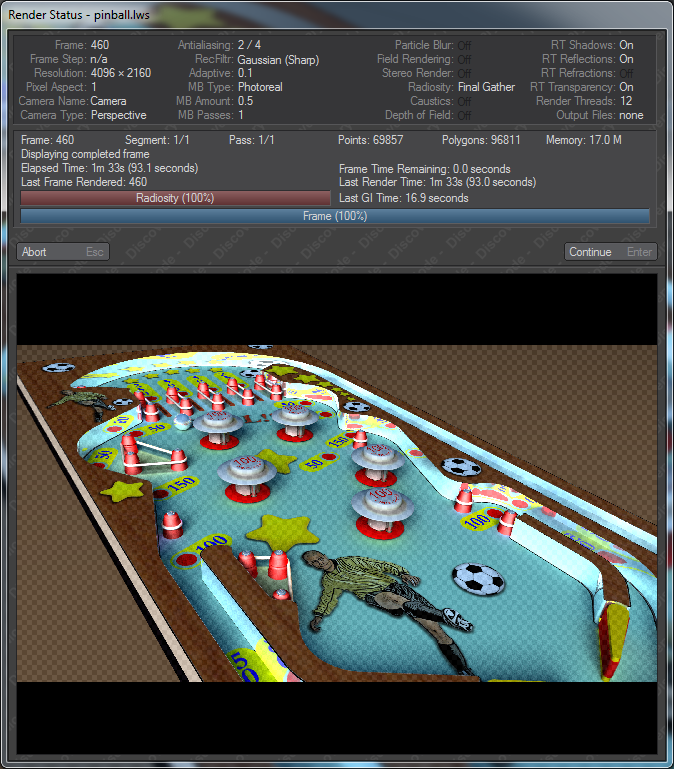
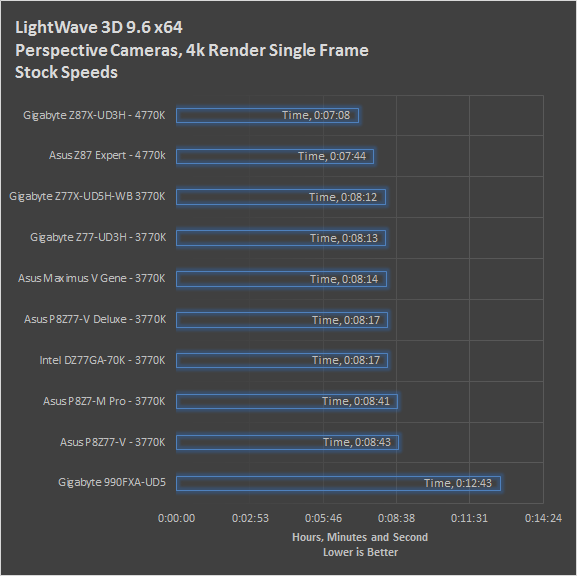
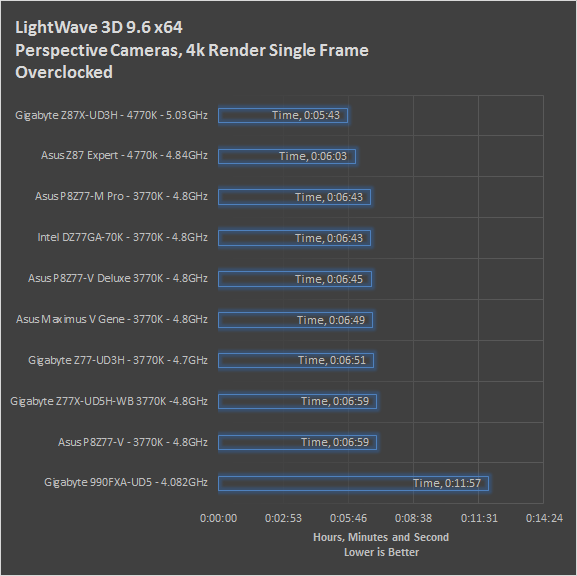
The rendering performance we see with LightWave 3D version 9.6 is pretty impressive. At stock speeds our 4k frame renders at around 7 minutes while our overclocked testing has us hitting just under 6 minutes (5:43). The impact of this is shown quite clearly in our project projections.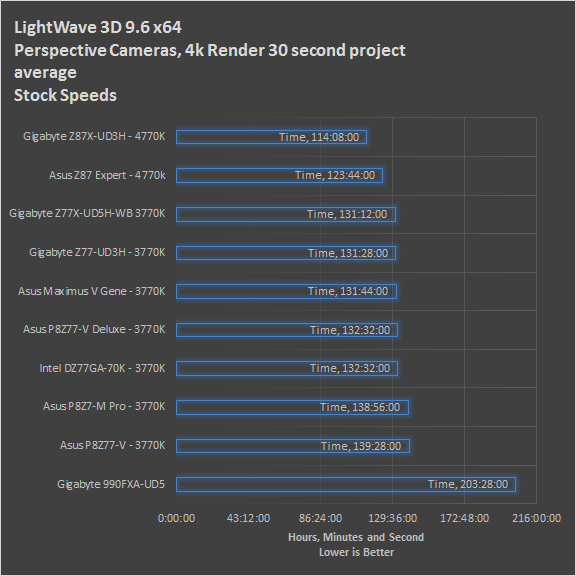
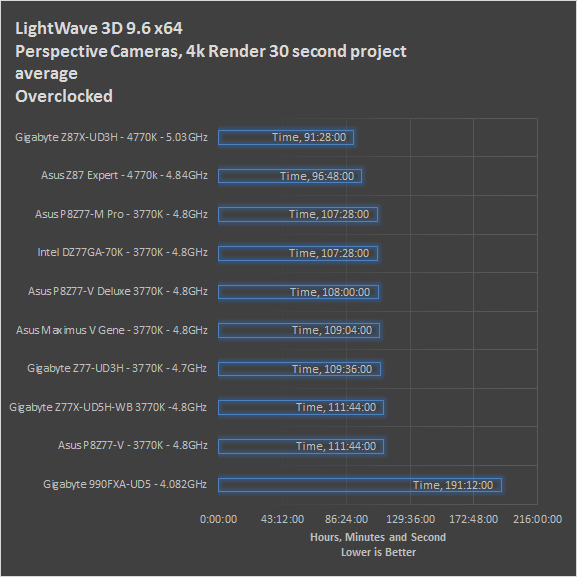
LightWave 3D 11 x64 -
Lightwave is another industry standard application for 3D animation and rendering. It has a large tool base and the rendering engine is highly threaded (when using the right render model). This application is also capable of expanding to 4k resolutions as well as ray tracing for rending the light sources. For our testing we use frame 308 of the Flocking-Alien Army scene found in the LW 11 Content folder. This uses perspective cameras which is better suited to a multi-CPU/Core environment. This camera style also uses ray tracing and a much improved anti-aliasing method. Settings are shown below in the attached screen shot. Of course these are single frame renders and they are not a complete picture; for that you have to take into account the number of frames an average project would have. In a typical 30 second commercial you will have around 840 to 960 frames (at 28 – 32 FPS) this means that you have to multiply the time of a single frame by that number just to get a vague idea of how long that 30 seconds would take. This is because each frame will have a different render time based on complexity.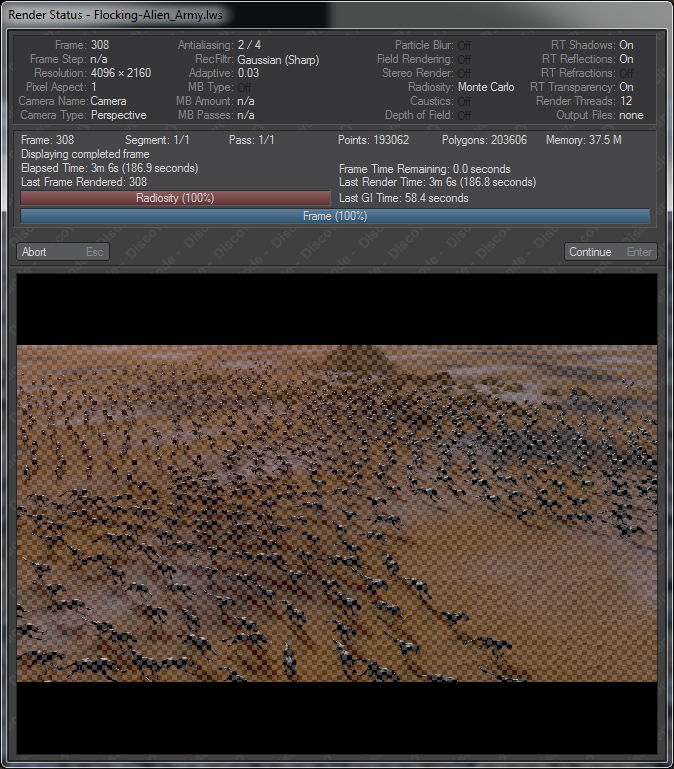
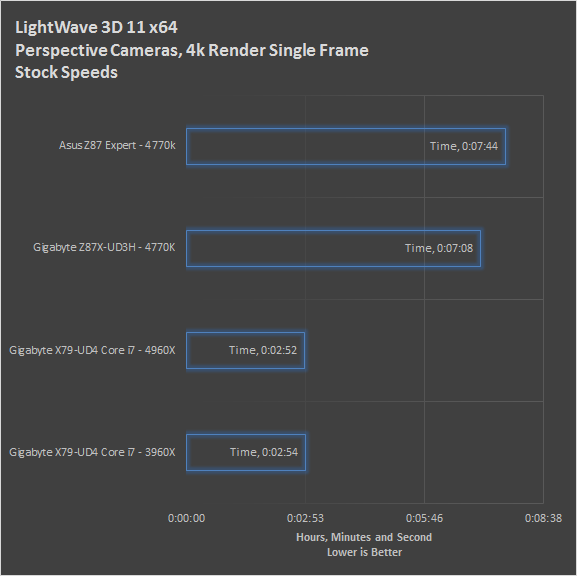
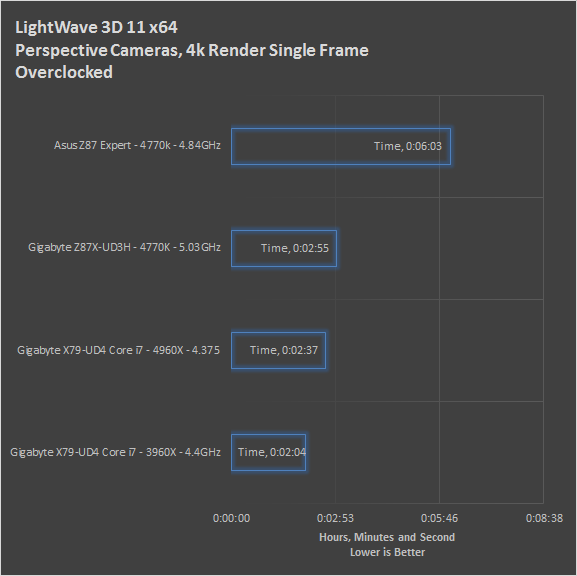
Here we see some interesting numbers. As we are just starting to use LightWave 11 in our testing we added in the Core i7 4960X and 3960X just for reference. This does make the numbers look a little odd, but does not hide the fact that the Z87X-UD3H does quite well in rendering under the pressure of the LightWave 3D 11 engine.
What is very interesting is that when we kicked the Intel 4770K up to 5GHz we hit performance levels that almost match what we see with the much more powerful 2011 Core i7 CPUs.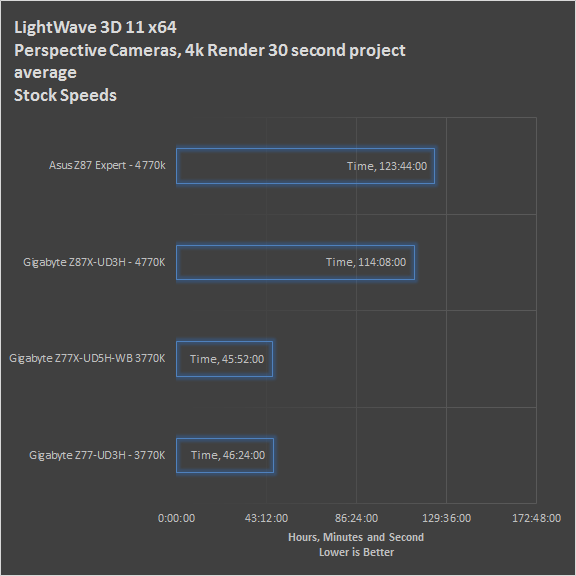
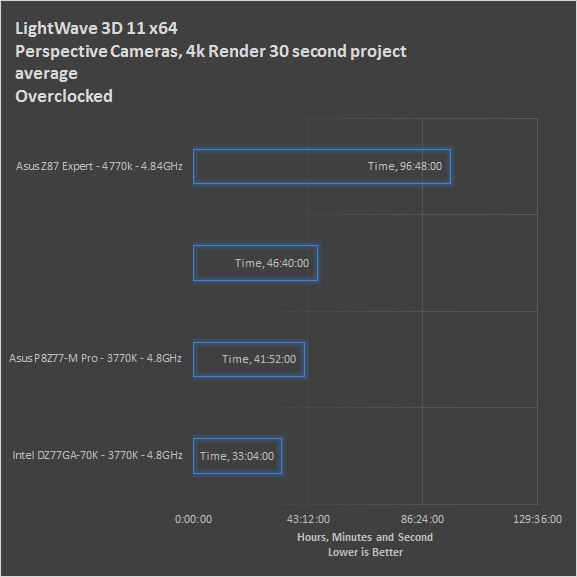
CyberLink Media Espresso 6.5 -
After having various issues with AutoGK and Intel CPUs with more than four cores we have changed our Media Encoding test to use Media Espresso from CyberLink. Although this new utility does not have the same ability to transfer directly from DVD it is still a good test to transfer different media types into a usable format for your iPad, iPod, or other media player. Our test involves using multiple (Six) 20 minute media files and transcoding them for an iPad. This gives us a very good indication of how well a motherboard can handle this type of work load.
Gigabyte’s Z87X-UD3H ends up on top in our transcoding tests… well it comes out on top by 3 seconds. Still it is almost two full minutes faster in transcoding tests over the older Z77+ Sandy Bridge/Ivy Bridge combination. In all we can see a real world example of Haswell’s multimedia improvements in this test.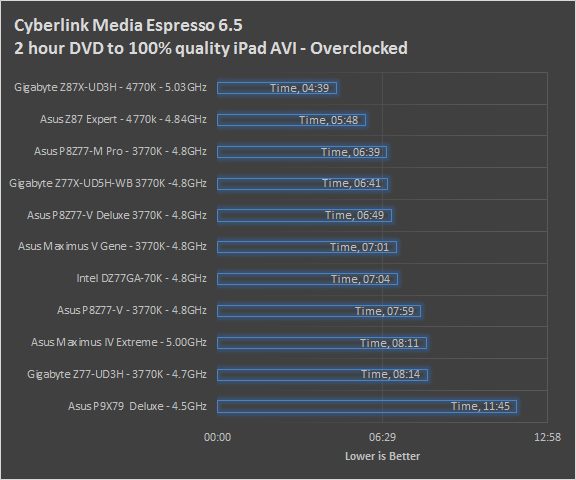
Section IV Performance – Gaming
Gaming as a test of motherboard performance is sort of a joke these days. The big player in the gaming arena is the GPU. Everyone but a few hardcore PR teams know this. However, it is important to run at least a few (one from each current DX version) to see if there are any issues with the combination of components on a motherboard. These are items like Audio lag, memory lag and of course problems with the PCIe lanes and signal traces. If there are issues in design, drivers or BIOS then you can have odd gaming performance. So without much more preamble let’s dive into the three games we currently use; Call of Duty Modern Warfare 3 and Total War Napoleon for DX9 and Civilization V for DX11.
Call of Duty Modern Warfare 3 DX9 -
As the third installment in the Modern Warfare franchise you are picking up some old roles while adding a couple of new ones as well. The game play is almost identical to what you are used to in Modern Warfare 2 as are the graphical settings. The AI is a little different thought it is still similar to the bar fight style AI we like in the Call of Duty series. For our testing we run the first mission (Black Tuesday) from start to finish. Settings are shown below.
 |
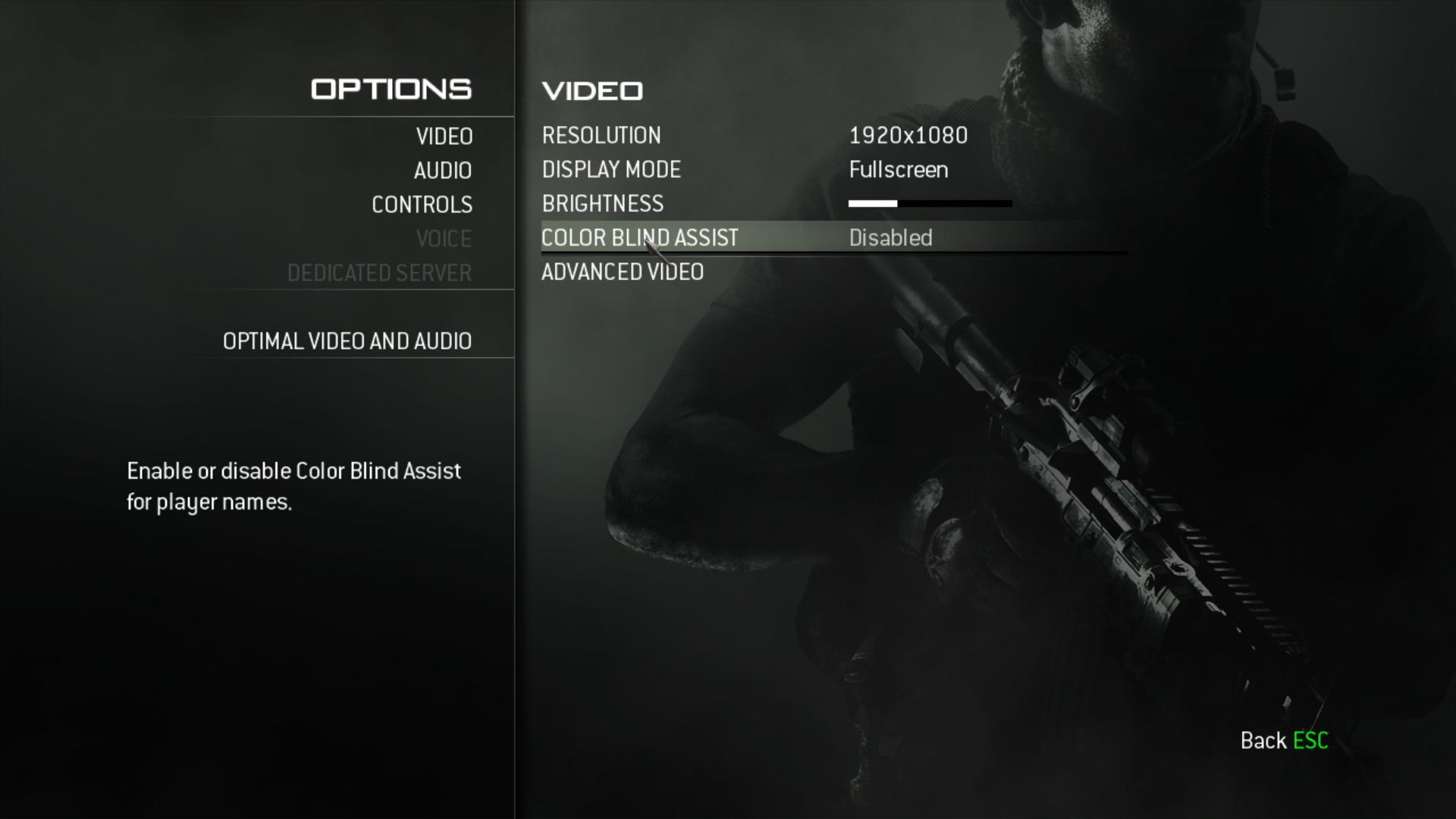 |
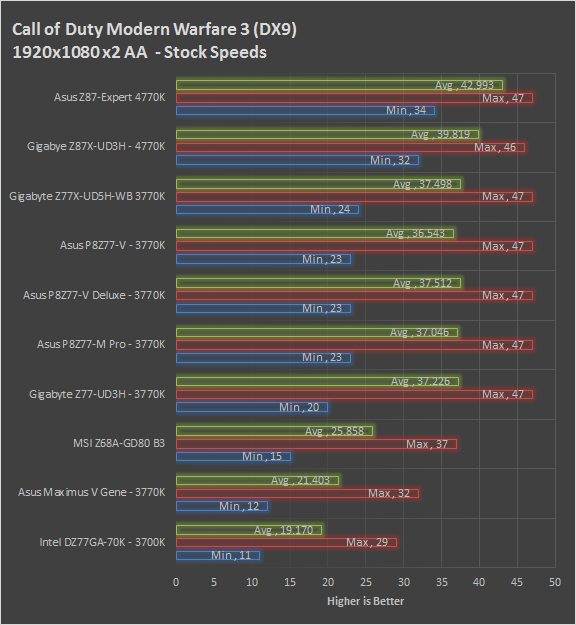
Gigabyte’s Z87X-UD3H did very well during our testing with Modern Warfare 3. We had a minimum frame rate above 32 FPS. This is very good for an internal GPU considering the resolution we were running at. Overall game play was good with no stuttering or major issues in performance.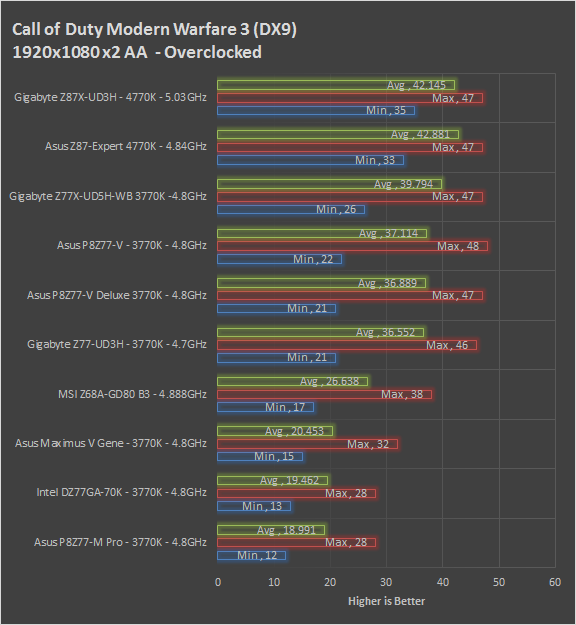
Total War Napoleon DX9 -
Napoleon Total War is a turn based strategy game that puts you in charge of Napoleon’s army during the height of his power. The game has some very interesting strategic systems although it can be boring when you are moving units into place. One of the more interesting things about Napoleon Total war is that the more CPU power you have at hand the better the game performs. This is because the system AI is dynamic and improves based on the resources available. For our testing we ran through the Lodi campaign. You can see the settings below.
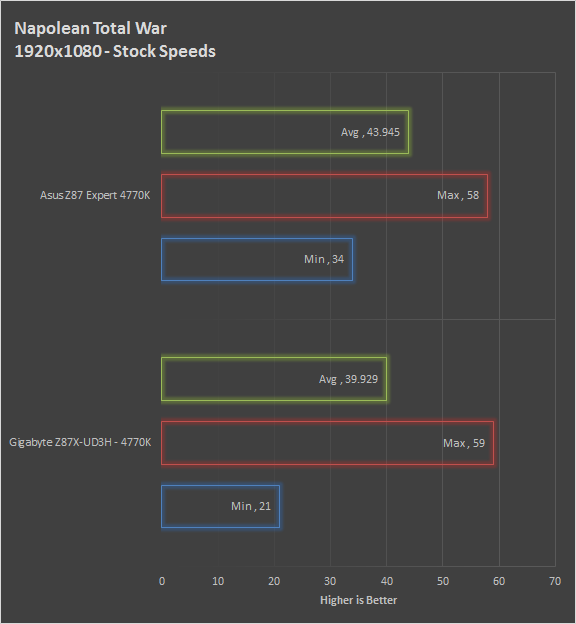
Under Total War Napoleon we saw the Z87X-UD3H was well behind competition, at least at stock speeds. When we overclocked the CPU to 5GHz it pulled out in front again with some excellent frame rates.
Civilization V DX11 –
Civilization V is a strategy game that pits you against other world leaders. You must advance your civilization and try to beat your opponents through military prowess, scientific achievement, or just lasting longer than they do. For our testing we ran through 30 minutes of game play using the same country and leader. We mapped out a city and production strategy attempting to move through the game the same way during all three test runs. You can check out the settings below along with a screenshot.

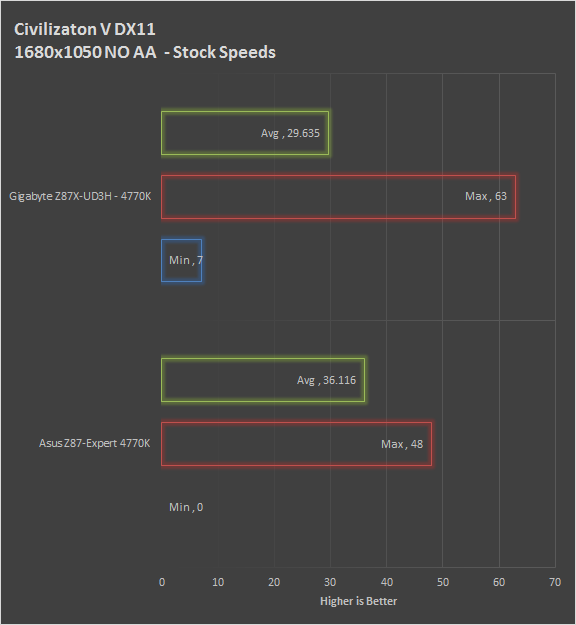
Civilization V is a lot tougher on a system than you would think. The way it renders is also unusual as there are times when the frame rate will drop to zero even with higher end GPUs. This is because there are times when the system pauses on a still image with no frame refresh. Looking at the performance using average frame rate the Z87X-UD3H comes in second place by 7FPS under stock speeds and pulls ahead by almost 3 FPS while running at 5GHZ.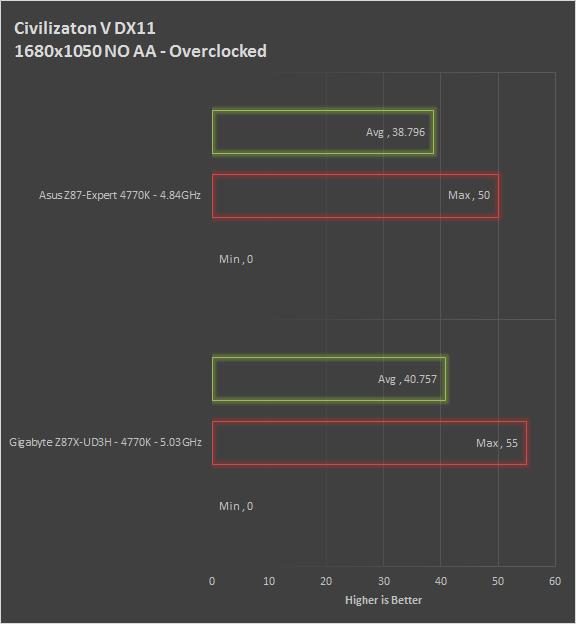
Gaming wrap-up -
The Z87X-UD3H running with the 4770K all on its own did quite well in our game tests. The frame rates were more than acceptable with the game we chose. Audio performance fell into the “good enough” category, but will still do the job for you. Of course the HD4600 is not meant as an enthusiast GPU so we would not recommend that you keep this if you want to play more demanding games.
Value -
Value is another very subjective topic. What is expensive to some might be a deal to others. You can look at this topic in multiple ways. One is raw price and the other is what you get for the money. Each is accurate and both are correct ways to look at price/value. We tend to look at features, performance and real-property when we discuss value. However, we also take into account the raw cash cost of the item.
According to Newegg and many other online retailers the Z87X-UD3H will only set you back about $160. To be honest this is a pretty amazing price considering the performance that we are seeing from it. There are not many Z87X-UD3H boards in the $160 price range that are hitting this level of performance and, of course, that can overclock as well as we are seeing here.
Conclusion -
Going into our review of the Z87X-UD3H we had some concerns about performance and especially overclocking. Lately we have not been all that impressed with Intel based motherboards simply because they are almost all just copies of each other with a slightly different feature set. We saw quite a bit of this with the Z77 chipset and expected the same with the Z87. However, the Z87X-UD3H did much better than we expected. We saw solid performance in ever test that we ran including gaming. On top of excellent stock performance we found that the Z87X-UD3H is capable of some serious overclocking. As we mentioned above we were able to push our Core i7 4770K to 5GHz. This is a clock we have never been able to hit before with our 4770K CPU. Gigabyte has packaged all of this will a very acceptable price ($160). When you put all of this together it you get a board that is certainly worthy of our Gold Key award.
 |
Tell us what you think in our Forum
